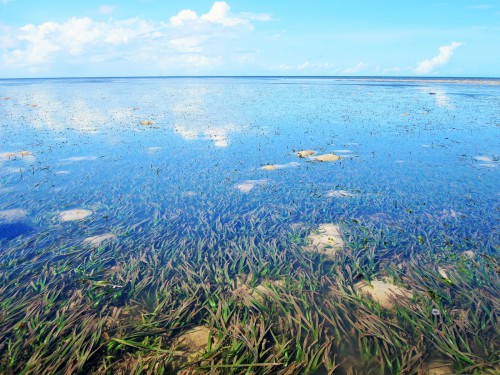Most of the heat from global warming has gone into the oceans, so it is no wonder that the seas are experiencing massive heatwaves too. What’s more, climate change is causing a fall in global ocean oxygen levels.
Hotter oceans, with less oxygen, sounds like bad news for marine life. But new research colleagues and I have published in Science Advances has shown how marine plants and organisms that live along the coasts – algae, seagrasses, mangrove and corals – can add oxygen to the water. We found this extra oxygen protects animals from heat stress and will make them more resilient to climate change.
Scientists have often studied the effect of temperature on the physiological response of marine animals. But, until now, the role of the oxygen produced by organism such as plants, algae and corals has been overlooked.

To see if this effect would be apparent across a variety of animals you’d find in the sea, we rounded up a total of 249 animals from six species belonging to four distantly related groups. Two of the species, we found in mangroves near our fieldwork site on the Saudi coast of the Red Sea: the spiny rock crab and the small silverside fish. From a nearby coral reef we found the black sea cucumber and the colourful fish Dascyllus. And finally we gathered up samples of the horsemussel and Ophiocoma, a “brittle star” closely related to starfish.
We then took these sample animals back to the lab, where we could measure their tolerance to increased water temperature at normal and high levels of oxygen. In this way, we could mimic the real condition these animals experience in the environment.
The animals we tested are all unable to “thermoregulate” like mammals, and so their metabolisms accelerate with the temperature. The warmer it is, the more oxygen is required.
We found that high levels of oxygen allowed them to cope with higher temperature. This is because oxygen is the combustive agent that helps them produce more energy from their food. (Something similar is also used in human medicine: hyperbaric oxygen therapy can form part of the treatment for cancers and other conditions.)
It makes sense, therefore, for these animals to live close to organisms like seagrass or coral which can guarantee a good supply of oxygen during the warmest hours of the day, when photosynthesis is also at its peak.
Our research also looked at which plants were responsible for adding oxygen to the water, and when. Every five minutes for a whole year we monitored the temperature and oxygen levels of the seawater among mangrove trees, seagrasses and a coral reef – again, all near our research site in the Red Sea. We showed that the level of oxygen in the water fluctuated significantly. In fact, during the warmest hours of the day it was more than double the normal saturation.
Mangroves, coral reefs and seagrass meadows are all vital for marine biodiversity, for fisheries and as habitable links to help individual animals jump from one population to another. But often they are threatened by human activities, such as dredge fishing and the expansion and development of coastal cities.
If more oxygen can make marine species more resilient to temperature stress then oxygen – and the organisms that generate it – must be taken into account in environmental policies along the coasts. In Scotland, for example, kelp is an important source of oxygen which may help associated animals face a rapidly changing environment. It therefore deserves scientific attention and governmental protection.
This article originally appeared in The Conversation UK. Read the original article here